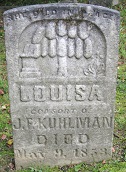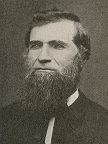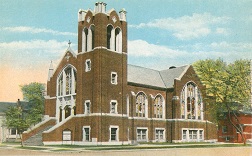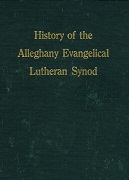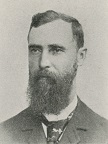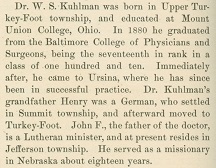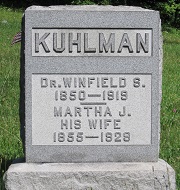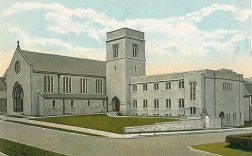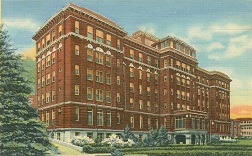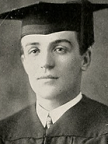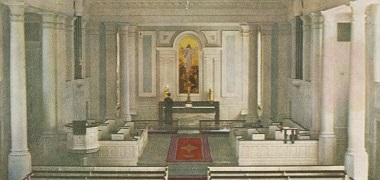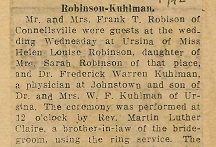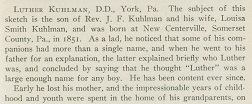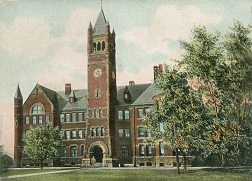
|
|
|
Louisa
(Smith) Kuhlman |
| See "Rev. J. Frederick Kuhlman - Sketch Prepared by Himself, Ponca City, Nebr., May, 1917" |
|
Younkin Cemetery |
Louisa (Smith) Kuhlman
was born in 1833 in Turkeyfoot Township, Somerset County, PA, the daughter of Garrison
and Hannah (Younkin) Smith.
Despite her tragic death at the age of 20, her
husband became a pioneer clergyman of Nebraska and remained so for six decades,
and her two sons rose above their misfortune to establish long, influential careers in
the fields of medicine and Christian ministry.
As a teenager, Louisa married German-born John Frederick Kuhlman (1829-1926), son of Henry and Elisabeth Kuhlman, emigrants from Oldenburg, Germany. Upon arriving in Somerset County, the immigrants settled "on what is known as the 'Baer Place,' east of the church," said the History of the Alleghany Evangelical Lutheran Synod of Pennsylvania.
The family name also has been misspelled "Coolman" and "Coleman." The couple resided in New Centerville, Somerset County
Frederick was admitted as a member of the St. Paul (Fritz) Lutheran Church congregation in or near Berlin, Somerset County, May 1847.
|
|
|
Rev. J.F. Kuhlman |
When the federal census was taken in 1850, Frederick was marked as a "joiner," a woodworking specialty. That year, they lived in the home of Louisa's parents (spelled "Coolman" by the census taker). He also was a local preacher.
The couple had two known sons -- Dr. Winfield Scott Kuhlman and Rev. Luther Kuhlman.
Tragedy rocked the family on May 9, 1853, when Louisa died at the age of 20, apparently in childbirth with a third baby. She was laid to rest in the family graveyard, with an elaborate stone carved to mark her final resting place. At the top was inscribed these words, "She died in peace."
The motherless sons were separated and taken into the homes of their grandparents, Winfield with the Smiths and Luther with the Kuhlmans.
Frederick did not remain unmarried for long. He wed again to Rachel Rush (1836-1881), daughter of "Squire" Jacob and Ruth (Scott) Rush of Somerset County. Theirs' was among many marriages between the Younkin and Rush clans over the years -- among them Rachel's first cousin Jacob J. Rush, who wed Sarah Dull. Others included Syvilla Younkin and John K. Rush; Henry F. Younkin and Mary King, daughter of John Christopher and Delilah (Rush) King; Sarah "Sally" (Younkin) Weimer and Thomas R. King, son of John Christopher and Delilah (Rush) King; Ross Younkin and Emma Rush -- he the son of Henry F. and Mary (King) Younkin and she the daughter of Jacob J. and Sarah (Dull) Rush. Click to view handwritten notes about Rachel and her family as made in the 1930s by researcher Otto Roosevelt Younkin.
Newspaper records for the Ebensburg Democrat & Sentinel show that Frederick performed marriages in Cambria County, PA in May 1859. As well, in 1859, he was pastor of a Lutheran mission in the town of Summerhill, and recruited 35 members to erect a house of worship in Jackson Township near Nanty Glo, Cambria County. He remained at the Jackson Township congregation until 1860.
The census of 1860 shows Frederick and Rachel together, having not yet reproduced, with his occupation as a Lutheran minister. They went on to have seven known children -- Lizzie Kuhlman (born 1861), John Kuhlman (1863), Emma Kuhlman (1865), Charlie Kuhlman (1868), Norman Kuhlman (1870), Albert Kuhlman (1873) and a young son who died during their lengthy cross-country trip in 1864.
The tragedy of war visited the family in mid-June 1864 when Rachel's brother Ross Rush, a member of the 85th Pennsylvania Volunteer Infantry, was killed during an infantry charge at the Battle of Petersburg, WV.
In June 1864, in the same month as his brother-in-law's death, Frederick received an exceptional and challenging assignment to travel to Nebraska. His objective was to make a preliminary assessment of the Lutheran Synod's efforts to minister to pioneer families and create local churches. After making the long trip by river and wagon, he first preached at Immanuel Church in Omaha. Then he traveled by stagecoach to Fremont, walking the final nine miles to the town of Fontanelle (then spelled "Fontenelle"), Washington County. Among his stops were two German settlements near Fontanelle and a visit to the town of West Point. He returned home to Pennsylvania and, after being offered a more permanent assignment in Nebraska, accepted the call and left Pennsylvania with his wife and children on Sept. 24, 1864.
For the next 18 years, Frederick served as a missionary in Ponca and Fontanelle on the outskirts of Omaha. The 1932 publication The Lutheran (Vol. 15), edited by George Washington Sandt, said that "The Nebraska of the pioneer missionaries, Henry Welty Kuhns, J. Frederick Kuhlman, Samuel Aughey, John George Groenmiller, W.I. Cutter, and Eli Huber, extended from a point a little south of Long's Peak in the Rockies, east to Iowa Point a little south of the Great Nemaha..." [link]
The work was anything but easy. Many of the early churches were rude sod houses. After establishing a preaching station in 1864 in the Logan Creek community, he tried to unite his group of German Lutherans with followers led by his colleague Rev. Kuhns. But according to records of St. Paul's Evangelical Lutheran Church of Hooper, NE, "arguments between the two groups led to a split and after failing to reunite them in 1869, Rev. Kuhlman resigned."
In May 1871, at a meeting at the Emmanuel Lutheran Church in Omaha, he was among a committee which asked to be recognized as an independent synod to govern local affairs in the west. Four years later, in 1875, now established in a home in Dakota City, Dakota County, NE, he traveled to Baltimore, MD for the biennial convention of the National Synod, and was elected president of the newly formed Nebraska Synod.
He was mentioned in this respect in the book History of Western Nebraska and Its People: General History, Vol. 1, by Grant Lee Shumway. Rev. Ira C. Billman served with him as the first secretary, and John B. Detwiler was initial treasurer. The History said that he and his colleagues Kuhns, Aughey, Huber and Groenmiller, "these five men, ... have very properly been regarded as the pioneers of the Nebraska Synod. They deserve to be remembered by those who are following in the trail they made. They did their work nobly in the face of difficulties the present generation know very little about." He also is named in the 1907 book Illustrated History of Nebraska, Vol. 2, by Julius Sterling Morton and George L. Miller.
|
|
|
First Evangelical Lutheran
Church, |
The federal census enumeration of 1880 shows the family living on Eleventh Street in Nebraska City, Otoe County, NE. The census-taker wrote Frederick's name as "John" and recorded that there were six children in the household. That year, he served as pastor of the First Evangelical Lutheran Church, and their 19-year-old daughter Lizzie worked locally as a school teacher. In connection with the Nebraska City work, Frederick was named in A.T. Andreas' book, History of the State of Nebraska (Chicago: The Western Historical Company, 1882).
In 1881, acting for the Home Mission Board, he served as pastor of the First Evangelical Lutheran Church of North Platte, NE, and helped to organize and build a church on several lots donated by the Union Pacific Railroad.
A local well-known personality of that era in North Platte was William F. Cody, known to millions around the world as "Buffalo Bill." He established a home in North Platte circa 1870 and in about 1883 founded his famous "Wild West Circus" near there. In 1886, Cody purchased a 4,000-acre ranch in the community which he named "Scout's Rest" and in which he resided for the rest of his life.
The Grim Reaper again victimized Frederick when sweeping away his second wife Rachel. She died on Sept. 21, 1881, age 45 years, 11 months and 26 days. Her remains were placed into rest in the Wyuka Cemetery in Nebraska City. Inscribed at the bottom of her upright grave marker were the scripture verse "For all live unto Him," taken from Luke 20:38. [Find-a-Grave]
Leaving Nebraska in the early 1880s, perhaps in grief, Frederick returned to Somerset County and made his home in Jefferson Township, Somerset County. While there in 1882, he was appointed pastor of the Mount Zion Evangelical Lutheran Church. Circa 1884, he served as pastor of the Mount Calvary Evangelical Lutheran Church of Lavansville, Somerset County, and translated from German into English old Samuel's Evangelical Lutheran Church records dating to 1791. He returned again to the west and later in 1884 performed a wedding in Roca, NE. A parishioner, Andrew Frankforter, once said that he had a great deal of affection for Frederick "in that he could read for him from his German bible which he prized so highly." In 1889 or '90 served in Kansas with the Zion's Evangelical Lutheran Church at Sabetha, Nemaha County, part of the Nebraska Synod.
|
|
|
History of the Alleghany Evangelical Lutheran Synod |
Heartache of a different sort rocked Frederick's world in June 1899, a time when he was residing in Martinsburg, Dixon County, NE. A cyclone blew in and his "home was swept away," said the Gettysburg (PA) Compiler. His son Luther, then serving as pastor of a church in Frederick, MD, was granted leave to visit the scene, and the congregation "made up a liberal purse for his unfortunate father."
Frederick was a longtime subscriber to The Lutheran Observer newspaper. After a decade as a widower, he married for a third time, to Mary Catherine Purvis (1850-1921), in December 1891. She was 21 years younger than he, and a native of Mattoon, Coles County, IL. They went on to have one son of their own, Frederick W. Kuhlman, born in 1893.
In May 1917, Frederick was in Ponca City, NE, perhaps for a meeting, and there authored an autobiographical profile, headlined "Rev. J. Frederick Kuhlman - Sketch Prepared By Himself, Ponca City, Nebr., May, 1917." The sketch was published in volume 1 of William Harrison Bruce Carney's 1924 book, History of the Alleghany Evangelical Lutheran Synod of Pennsylvania. [Full text]
Frederick and Mary Catherine spent their final years in retirement in Pawnee County, NE, as shown on the 1910 and 1920 censuses. In 1910, their home was in South Fork, NE and in 1920 was in Pawnee City. In 1919, he received word of the death of his eldest son Winfield back in Somerset County, PA.
Mary Catherine passed away on Nov. 26, 1921. Burial was in the Pawnee City Cemetery in Pawnee County, NE. Frederick thus was widowed for a third time in his long life, this time at the age of 92. He lived for another five years. His final three years were spent residing in the Tabitha Home, a Lutheran retirement facility in Omaha, where he preached for the final time on Easter Sunday 1925.
Having fought the good fight, having finished the course, having kept the faith, Frederick died at the age of 97 on June 8, 1926 in Lincoln, Lancaster County, NE. An obituary in the Lincoln Star included his photograph and noted that he was not only "Nebraska's oldest Lutheran minister" but that "a large delegation of his former parishioners is expected to attend." Following a funeral led by Rev. E. Walters, his remains were transported to Pawnee City to be placed into holy rest beside his wife in the city cemetery. [Find-a-Grave] The Star also reported that his survivors included "Mrs. E.R. Stein of Hastings; Miss Elizabeth Kuhlman of Chicago; Rev. Luther Kuhlman of Gettysburg, Pa.; John A; Charles B. of Holden, Neb.; Albert of Sidney, Neb. and Dr. Fred W., associated with the Methodist hospital of Omaha."
His sons Luther and Frederick, of different mothers, served as co-executors of the estate, which totaled $7,300 in value.
At least six of their offspring and spouses became physicians, and five entered the clergy.
|
|
|
Dr. Winfield Kuhlman |
~ Son Dr. Winfield Scott Kuhlman ~
Son Dr. Winfield Scott Kuhlman (1850-1919) was born on May 20, 1850 in Upper Turkeyfoot Township, Somerset County. He was but a toddler when his mother died, and he was taken into the home of his Younkin grandparents and raised to adulthood, while his brother went to live with the other grandparents.
Seeking an education beyond local schools, Winfield attended Mount Union College in Ohio. At the age of 30, in 1880, he obtained his medical degree at the Baltimore College of Physicians and Surgeons, ranking 17th among a class roster of 110 students.
Winfield returned to Ursina, Somerset County, where he spent the remainder of his life and career. He married Martha Jane Walter (1855-1928), daughter of Alex W. and Mary Ann (Cramer) Walter of Kingwood, Somerset County.
|
|
|
History of Bedford, Somerset
and |
They together bore a family of these eight known children -- Luther Orvill Kuhlman, Russell E. Kuhlman, Edgar "Roy" Kuhlman, Mabel Alice Clare, Dr. Mosheim W. Kuhlman, Dr. Harry S. Kuhlman, Mary Edna Wentz and Dr. Frederick Lincoln "Warren" Kuhlman. Sadly, infant son Luther died in about 1876 and was buried at Ursina Cemetery.
Interestingly, perhaps following the precedent set by Winfield's father, his Walters in-laws retired from farming and relocated to Nebraska, making their home in Kennebec, Dawson County in 1900.
Reflecting his growing and influential status in the community, Winfield was profiled in the 1884 book History of Bedford, Somerset, and Fulton Counties, Pennsylvania, authored by Chicago's Waterman, Watkins & Co. In September 1899, he authored a technical article published in the Canadian Journal of Medicine and Surgery, Vol. 6. The piece was entitled "Typhoid Fever, Pneumonia and Septicemia -- Five Cases Treated with Viskolein," describing his use of a type of disinfecting fluid of the era.
He was a longtime member of the Medical Society of the State of Pennsylvania and served as an officer of the Somerset County Society, including service as its president in 1896. The Pennsylvania Medical Journal reported in 1904 that he was no longer a member of the Somerset County Society.
He also was a member of the governing council of the Evangelical Lutheran Church of Ursina, and the Independent Order of Odd Fellows (IOOF). In June 1884, he led a teaching session at the Eighth Annual Convention of the Lutheran Sunday School Association of Somerset County, and his father also gave a teaching at the event, receiving news coverage in the Somerset Herald. Circa 1897, he was a school board director of the Ursina schools.
|
|
|
Ursina landmarks where Winfield served in governance -- Evangelical Lutheran Church (left) and public school |
Winfield suffered a stroke of paralysis and passed away four days later on Oct. 24, 1919, at the age of 59. He was laid to rest in the Ursina Cemetery.
|
|
|
Ursina Cemetery |
Martha outlived her husband by nine years, and relocated to Apollo, Armstrong County, PA, where her son in law Dr. Martin L. Clare was pastor of the local Lutheran church. There, suffering from liver cancer, she died on April 8, 1929, at the age of 73. Her remains were shipped to Ursina for burial.
Winfield is named and pictured in volume 2 of William Harrison Bruce Carney's 1924 book, History of the Alleghany Evangelical Lutheran Synod of Pennsylvania, which also contains a photo and memoir of his father.
Son Russell Kuhlman (1873-1962) was born in February 1873 (or 1875 or 1876) in Ursina. He migrated as a young adult to Nebraska, where he established a residence in Kennabec, Dawson County. In 1900, not yet married, he resided in Kennabec with his mother's parents and earned income as a live stock dealer. At the age of 30, in about 1906, Russell married 24-year-old Florence Agnes (?) (1881-1967), a native of Illinois. They had three known children -- Florence Kuhlman, Russell Wayne Kuhlman, Clara Kuhlman and Ross Kuhlman. When the federal census was taken in 1920, the family dwelled in Lexington, Dawson County, with Russell listed as a farmer. By 1930, he had changed employment and was driving trucks for an oil and gas company. He remained in Dawson County for the rest of his life. He died on April 7, 1962, with burial in Lexington's Greenwood Cemetery. Alice followed him to the grave five years later, on July 2, 1967.
- Granddaughter Florence Kuhlman (1909- ? ) was born in 1909 in Nebraska. In 1930, at age 21 and living at home with her parents, she earned a living as a school teacher. She is named in the 1924 edition of the annual report of the Nebraska State Board of Agriculture.
- Grandson Russell Wayne Kuhlman (-1911-) was born on Jan. 22, 1911. He only lived for less than two months, dying on March 13, 1911. His tender remains were placed into rest in Hewitt Cemetery in Dawson County.
- Granddaughter Clara Kuhlman (1915- ? ) was born in 1915 in Nebraska.
- Grandson Ross Kuhlman (1919- ? ) was born in 1919 in Nebraska.
Son Edgar Roy Kuhlman (1879-1942) was born on April 12, 1879. Circa 1900, when he was 21 years of age, he lived at home and was employed as a postal clerk. By 1910, unmarried at 25, he took a position as a laborer on the "street railroad" in Ursina. He learned the electrician's trade and migrated to Latrobe, Westmoreland County in about 1914. He married Mary (?) and resided at 725 Chestnut Street. In the waning days of the year 1941, he became afflicted with skin inflammation called herpes zoster. Ten days later, on Jan. 9, 1942, he was felled by a cerebral hemorrhage and died at the age of 61. He was laid to rest in the Unity Cemetery in Latrobe.
|
|
|
First Evangelical Lutheran Church, Apollo |
Daughter Mabel Alice Kuhlman (1881-1960) was born in September 1881. She attended college away from home in 1900, when she was age 18. On June 26, 1907, when she was 25 years of age, she wed 27-year-old Rev. Dr. Martin L. Clare (1879- ? ), son of Richard and Catharine Clare of Spring Grove, York County, PA. Alice's uncle, Rev. Luther Kuhlman, officiated in the ceremony, held at Ursina. Martin's occupation at the time was listed as "Minister of Gospel." They produced five children -- Rev. Luther K. Clare, Dr. David W. Clare, Mrs. L.A. Kenney, Edna Mary Clare and John R. Clare. As he began his career in 1906-1907, Martin was active with the Evangelical Lutheran Synod of West Pennsylvania, serving on the Apportionment Committee. He accepted a position in 1907 as pastor of the St. Paul's Lutheran Church in Spring Grove, where he remained for seven years. While in Spring Grove, in February 1914, the Clares' parsonage home was invaded by burglars, but surprisingly, reported the Gettysburg Times, jewelry and silverware was untouched, and a dresser drawer which was ransacked contained an envelope with more than $20. Martin resigned from Spring Grove in 1914 to become pastor of the Apollo Lutheran Church in Armstrong County, PA, remaining for more than three decades. In 1918, he authored the book Foundation Stones for Lutheran Boys and Girls, published locally in Apollo. For his work at Apollo church, he was named in the book 1816-1916 - History of Apollo, Pennsylvania: The Year of a Hundred Years, authored by Thomas James Henry. He also helped organize the Shady Plain Red Cross Auxiliary in June 1917. Also during his tenure at the church, the congregation raised $187,000 to construct a new church building, dedicated on Reformation Sunday, Oct. 31, 1926. Circa 1934, Martin served as president of the board of trustees of Thiel College in Greenville, PA. Mabel died at the age of 79 in Apollo on Oct. 4, 1960. They are mentioned in Rev. W.H. Bruce Carney's 1918 book History of the Alleghany Evangelical Lutheran Synod of Pennsylvania, volume II.
- Grandson Rev. Luther K. Clare (1908-1989) was born on May 16, 1908. He is believed to have served a church in Butler, Butler County, PA in 1938. By 1947, he was minister of Christ Lutheran Church, Mozart, PA. In July 1957, he began his tenure as pastor of St. Paul's Lutheran Church in Erie, and remained until May 1972. He is believed to have resided in retirement in Myrtle Beach, Horry County, SC and to have passed away on Oct. 26, 1989.
- Grandson Dr. David W. Clare (1917-1997) was born on April 6, 1917. He is believed to have wed Gail Bowser (1918-2007), daughter of Wilber Roy and Retta (Heilman) Bowser. They had five children -- D. Stephen Clare, Michael W. Clare, Timothy P. Clare, Molly E. Clare and Nicholas J. Clare. He practiced in Pittsburgh and in 1964 was chief of surgery at the newly opened Passavant Hospital in the North Hills. He also was a forceful advocate for smoking cessation. He died on Sept. 24, 1997. In her final years, Gail resided in Marietta, OH. She died in Marietta at age 89 on July 2, 2007, with an obituary published in the Pittsburgh Tribune-Review. Interment is thought to have been in Homewood Cemetery in Pittsburgh. A fund for education was established in David's name with the Foundation of the Pennsylvania Medical Society.
- Granddaughter (?) Clare wed L.A. Kenney and made their home in Glens Falls, NY.
- Granddaughter Edna Mary Clare called Philadelphia home in 1960.
- Grandson
John R. Clare lived in Pittsburgh.
|
|
|
|
Conemaugh Valley Memorial Hospital |
|
|
|
Dr. Mosheim Kuhlman |
Son Dr. Mosheim Walter Kuhlman (1884-1958) was born on May 28, 1884 in Ursina. He was married to Laura Frances Schafer, RN (1884-1963), a native of Washington, DC. Laura is said to have traced her family lineage to George Washington's mother through the Ball family of Virginia. He was to have graduated in 1911, but was stricken with typhoid fever as a sophomore and so forewent his studies in order to recuperate. His entry in the 1912 Year Book of the College of Physicians and Surgeons reads: "He occupies a seat in the pallbearer's row in the class room and takes every lecture verbatim, even the sneezes, coughs and pauses are duly recorded., together with the applause from the gallery. He will be a tall oak in his profession." Mosheim graduated from Gettysburg College and received his medical degree in 1912 from the College of Physicians and Surgeons in Baltimore, later part of the University of Maryland. Laura received her nursing degree from Johns Hopkins University, graduating in 1913. When the federal census was taken in 1920, the couple resided in Jenner Township, Somerset County, where he was working as a physician. Later, they relocated to Johnstown, Cambria County, PA. For many years Mosheim was chief of staff of the Johnstown Memorial Hospital, sometimes known as Conemaugh Valley Memorial Hospital. Their address was 437 Park Avenue in Johnstown. They often spent weekends and vacation times visiting in Gettysburg with his sister Edna Wentz. In 1936, at the death of his prominent uncle Rev. Luther Kuhlman, Mosheim was named to serve as co-executor of the estate, along with his brother in law Rev. Dr. Abdel Ross Wentz. Afflicted with arteriosclerosis (hardening of the arteries), he suffered an acute heart attack and died within 30 minutes on May 12, 1958, at the age of 73, with burial beside his wife in Johnstown's Grandview Cemetery. A brief notice of his death was printed in the Gettysburg Times. Laura survived for another five years and died on July 14, 1963, at the age of 79.
|
|
|
Laura in young womanhood, in nursing school and tending a fire with Mosheim |
Son Dr. Harry Stanley Kuhlman Sr. (1886- ? ) was born in December 1886. He attended the Baltimore College of Physicians and Surgeons. He married Ada C. (?) (1892- ? ) and had twin sons, Robert S. Kuhlman and Harry Stanley Kuhlman Jr. Their home in 1916 was Kemptown, MD. When the federal census was taken in 1920, they lived in Jefferson Township in Frederick County, MD. The twins both were students at Gettysburg College circa 1936. Ada suffered a heart attack and died on March 4, 1966. Funeral services were held in Seaford, DE, followed by burial in Lehighton, Carbon County, PA. Harry's fate is not known.
- Grandson Robert S. Kuhlman (1919- ? ) was born in 1919 in Pennsylvania, a twin with his brother Harry.
- Grandson Harry Stanley Kuhlman Jr. (1919- ? ) was born in 1919 in Pennsylvania, a twin with his brother Robert.
|
|
|
Chapel at Gettysburg Lutheran Seminary, the Church of the Abiding Presence |
Abdel Ross
Wentz Abdel Wentz's book
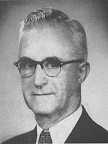
Daughter Mary "Edna" Kuhlman (1889-1982) was born in 1889 in Ursina. She grew to womanhood and spent her high school and college years in Gettysburg, presumably living with her uncle and aunt, Rev. Luther and Alice Kuhlman. Later, she attended Northwestern University in Chicago and in June 1917 received a degree from Syracuse University. In mid-August 1917, she married Rev. Dr. Abdel Ross Wentz (1883-1976) of Gettysburg, in a ceremony officiated by her uncle Dr. Luther Kuhlman. They had
three known children -- Valentine Wentz, Dr. Frederick Kuhlman Wentz and Mary Louise Beckstrand. Abdel was a graduate of Gettysburg College (1904) and its seminary (1907) and then took further studies in Germany. Returning to Gettysburg prior to marriage, Abdel was a professor of
English Bible in the college before taking a post as a professor in the seminary. Upon marriage, the couple lived on famed Seminary Ridge, site of intense fighting during the Civil War's most famous and bloody battle. They were members of the Christ Lutheran Church. They lived in Black Rock, PA at the time their daughter was born in 1922. Tragedy rocked the family in 1936, when 17-year-old son Valentine, a student at Mercersburg Academy, died of scarlet fever followed by a kidney infection. He was a prolific writer, and in his lifetime Abdel was the author or editor of 19 known books, all containing some narrative relating to the history of the Lutheran church tradition. In an article headlined "Workers for Church Unity," he was pictured in Life Magazine (edition of May 17, 1948). By 1966, the Wentzes made their home in Columbia, SC, where he was on the faculty of the Lutheran Southern Seminary. In 1968, they moved back to Gettysburg. At
some point Abdel served as president of the seminary in Gettysburg. He passed away in 1976 and is buried in Gettysburg's Evergreen Cemetery. Edna survived for another six years and moved to Illinois near her daughter Mary Louise. She died in Rockford, IL at the age of 92 on March 13, 1982. Her remains were transported back to Gettysburg for interment.
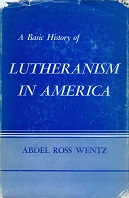
|
~ Publications by Rev. Dr. Abdel Ross Wentz ~ |
|
When Two Worlds Met: The Diet at Works,
1521. United Lutheran Publishing House, 1921
Luther, Martin. The Word and Sacrament. 4 volumes. Edited with E. Theodore Bachmann, Robert H. Fischer and Martin E. Lehmann. Fortress, 1959. Fliedner the Faithful. Philadelphia: United Lutheran Church in America, 1936. A Basic History of Lutheranism in America. Philadelphia: Muhlenberg Press, 1955. The Beginnings of the German Element in York County, Pennsylvania. Lancaster, PA: Press of the New Era Print Co., 1916. The Lutheran Church in American History. Philadelphia, United Lutheran Publication House, 1933. History of the Gettysburg Theological Seminary..., 1826-1926. Philadelphia: United Lutheran Publication House, 1927. History of the Evangelical Lutheran Synod of Maryland of the United Lutheran Church in America, 1820-1920. Harrisburg, PA: Evangelical Press, 1920. The Lutheran Churches of the World, 1952. Geneva: Lutheran World Federation, 1952. |
Genealogical Resources in the Abdel
Ross Wentz Library of the Lutheran Theological Seminary, Gettysburg,
Pennsylvania. Gettysburg: 1961.
A Wentz Festschrift. With Theodore G. Tappert; Leigh D. Jordahl; Robert H. Fischer. Gettysburg: Lutheran Theological Seminary, 1968. Across the Barriers of Language. New York: American Bible Society, 1934. A History of Evangelical Lutheran Church 1738-1988. Frederick, MD.: University Publishing Group, 1988. Our Church and Our Times. No place, no date. History of the Evangelical Lutheran Church of Frederick, Maryland, 1738-1938. Harrisburg, PA: Evangelical Press, 1938. A New Strategy for Theological Education. 1937. The Columbiona Fellowship, a New Approach to a United Christendom: an Interpretation of the Columbiona Movement. 1930s. Toward a Better Ministry. Gettysburg: 1940. Martin Luther in the Changing Light of Four Centuries. Gettysburg: Gettysburg Compiler Print, 1917. |
- Grandson Rev. Dr. Frederick Kuhlman Wentz ( ? - ? ) married Marion "Mani" Benson (1923-2009), daughter of John William and Lisen (Anderson) Benson of New Haven, CT. They had three children -- Theodore Valentine Wentz, Lisa J. Wentz and Melania K. Wentz. Frederick obtained his Ph.D. degree and in 1965 served on the faculty of the Lutheran Theological Seminary in Gettysburg. By 1967, he had joined the faculty of the Hamma School of Theology in Springfield, OH. In 1977, he was named in Who's Who in Religion. He was based in Chicago in 1982 and, upon retirement, returned to Gettysburg. He is said to have authored eight books on modern church history and the ministry of the laity. Interested in broader history, he was involved with the Seminary Ridge Historic Preservation Foundation and the Lutheran Historical Society. Prior to marriage, Marion was secretary to the headmaster of Hopkins Grammar School in New Haven and later was secretary to the dean of Chicago's Lutheran School of Theology. Marion died at the age of 86 the day after Christmas 2009.
|
~ Publications by Rev. Dr. Frederick Kuhlman Wentz ~ |
|
The Hospital on Seminary Ridge at the Battle of
Gettysburg. By Michael A. Dreese. Jefferson, N.C.: McFarland & Co.,
2002. Foreword by FKW.
Expanding Horizons for America's Lutherans: Story of Abdel Ross Wentz. Gettysburg: Seminar Ridge Press, 2008. "A Narrowing of Ministry." Word & World Spring 1992 The Church In The Americas Since 1492. Evidence of Crowd Phenomena at Pentecost. Manuscript. 1946. The Reaction of the Religious Press in America to the Emergence of Nazism. Manuscript, 1954. |
Witness at the Crossroads: Gettysburg Lutheran Seminary
Servants in the Public Life. Gettysburg, PA: Lutheran Theological Seminar, 2001. With Paul A.
Baglyos; Michael J. Kurtz; Nelson T. Strobert; Robert H. Fischer; Mark W. Oldenburg; Maria E.
Erling; Stephen R. Herr; Matthew L. Riegel; Susan C. Hill; David P. von
Schlichten; Darold H. Beekmann; Lawrence D. Folkemer; Dale R. Lind; Carl T.
Uehling; Kenneth C. Senft
"Ecumenical Movement as Fulfillment of the Reformation." Lutheran Quarterly, Vol. 13, 1961. |
-
Granddaughter Mary Louise Wentz (1922-2013) was born on July 9, 1922 in Gettysburg. She obtained her education at Gettysburg College and was a teacher of English, French and Latin. On June 28, 1945, when she was 23 years of age, she married 24-year-old Rev. Dr. Otto Garfield Beckstrand II ( ? -1995), son of Otto G. and Agnes (Anderson) Beckstrand Sr. The couple had four children -- Barbara Abbett, Martha Schank, Karen Stout and Garfield Wentz Beckstrand. At the time of marriage, Otto resided in Fort Wayne, IN, where he was assigned to minister to a church congregation. From 1947 to 1982, they resided in Rockford, IL, where Garfield was pastor of the Trinity Lutheran Church and she was a substitute teacher in the Rockford public high schools. She also taught Bethel Bible classes and services with women's groups in the church. In 1958, they endured the untimely death of their son Garfield. Upon retiring from Trinity, Garfield accepted a position as pension representative for the Lutheran Church which meant traveling throughout the United States. After brief residences in Gettysburg and Maryland, they shared the rest of their retirement years in homes in Fort Myers, FL and Egg Harbor, WI. After Garfield's death in 1995, Mary Louise resided in Lake Barrington, IL. She passed away on March 16, 2013 in Lake Barrington. She was laid to rest in the Scandinavian Cemetery following funeral services led by Rev. Jay Quinn.
|
Connellsville newspaper, 1920 |
Son Dr. Frederick Lincoln "Warren" Kuhlman (1892- ? ) was born on July 3, 1892 in Ursina, Somerset County. He was tall and slender, with blue eyes and brown hair. After the outbreak of World War I, he was required to register for the military draft, and at the time was a student at the University of Pittsburgh Dental School. He joined the U.S. Army where he held the rank of sergeant during the war. He followed his father's interest in the medical field and became a dentist, practicing in Johnstown, Cambria County, PA. At the age of 28, on Aug. 18, 1920, he wed 23-year-old teacher Helen Louise Robinson (Oct. 8, 1897-1980), daughter of Charles Frederick and Sarah Catherine (Ansell) Robinson of Ursina. The marriage ceremony was performed In Ursina by Frederick's brother in law, Rev. Martin L. Clare. Reported a Connellsville newspaper, "The bride wore her traveling suit and hat to match. Miss Martharine Hostettler of Ohiopyle, niece of the bride, played the wedding march." Guests were Mr. and Mrs. Frank T. Robinson of Connellsville, Mr. and Mrs. Roy Kuhlman of Latrobe, Mr. and Mrs. W.M. Kuhlman of Jeannette, Mrs. W.F. Payne and daughter Mildred of Meyersdale, Mrs. R.C. Holt and daughter Jean of Ohiopyle, Mr. and Mrs. M.H. Hostettler and family of Ohiopyle, and Mrs. Neil Bullions of Chicago. After a honeymoon to Niagara Falls and Gettysburg, they first established a home in Johnstown. Their marital union endured for six decades. The couple produced two daughters -- Jane K. O'Dell and Eleanor L. Bone. They later resided in Pittsburgh, and in 1938 Warren traveled to Camp Oglethorpe to receive special education in the Army Medical Corps. He again had to register for the military draft during World War II, At that time, he and Helen lived at 202 Worth Street in Johnstown, and his independent dentistry practice was housed in the U.S. Bank Building in the city. He was a longtime member of the Kiwanis Club, Masons lodge, Pennsylvania Dental Association and American Dental Association, and served as president of the Cambria County Dental Association. After retirement, Warren and Helen relocated in 1967 to Winter Park, FL and appear to have remained for good. Sadness cascaded over the family when Helen died at the age of 83 on Oct. 24, 1980 in Orange County, FL. Warren outlived his wife by five years and was named in the 1982 Gettysburg Times obituary of his sister Edna Wentz. He died on Aug. 3, 1985. Interment of the remains was in Chapel Hill Cemetery in Orlando. An obituary was published in the Orlando Sentinel.
-
Granddaughter Jane Kuhlman wedded (?) O'Dell. In 1980, she was in Bloomington, IL and in 1985 in Maitland, FL.
-
Granddaughter Eleanor L. Kuhlman ( ? -2016) was born in Johnstown, Cambria County. She received a degree from Allegheny College, and as a student there met her future husband. On May 9, 1953, she was joined in holy matrimony with Howell "Darcy" Bone (June 14, 1931-2015), who by that time had joined the U.S. Air Force. Their marriage endured for an extraordinary 62 years. Darcy as a young man attended Young Harris Preparatory School in Georgia before obtaining his degree at Allegheny. Offspring born to their union were Fred Bone, Marcia Rabun and Diane Pou. The couple resided for 38 years in Winter Park and Maitland, FL and were members of the Asbury United Methodist Church of Maitland. Eleanor spent 17 years teaching at Brookshire Elementary School. She also spent a decade of employment with the Winter Park law firm of Hunter and Marchman. Darcy's career was in the supermarket business in Ashland, OH before their move to Winter Park. He served as manager of the Gooding's Supermarket in Maitland and retired in 1992 after 27 years of service. Once in Maitland, he became interested in politics, first as a member of the Planning and Zoning Committee and then from 1984 to 1988 on City Council. He was elected Mayor of Maitland in 1988 and held the position over two terms until 1993. Among his interests in politics and community development were term limits and a balanced municipal budget, while pushing for the 26-acre Brookside Park. He held the title of Maidland's "Goodwill Ambassador" for three years, from 2000 to 2003. Reported the Orlando Sentinel, Eleanor "was an accomplished pianist, violinist & painter. She loved singing in her church choirs." Circa 2003, the Bones migrated to Hoover, AL to be close to their married daughters. Darcy passed into glory at the age of 83 on or about March 23, 2015. At the age of 85, Eleanor died on Oct. 28, 2016. The remains were lowered into eternal sleep in Maitland, FL. In an obituary in the Sentinel, the family asked that any memorial donations be made to the Dr. Anthony Pattin Steinway Endowment Fund in care of the University of Montevallo Foundation.
Great-grandson Frederick "Fred" Bone married Nancy and has lived in Tuscaloosa, AL.
Great-granddaughter Marcia Bone wedded Patrick "Pat" Rabun. In 2002, they were called to serve at the chapel of the Pines Presbyterian Church of Hoover, AL. They were in Wrightsville Beach, NC in 2016.
Great-granddaughter Diane Bone was joined in marriage with Jacob Pou. Circa 2016, they were in Hoover, AL. Jacob has built a career with Publix Super Markets.
~ Son Rev. Luther Kuhlman ~
Son Rev. Luther Kuhlman (1851-1936) was born on Nov. 8, 1851 in New Centerville, Somerset County. He was but a baby when his mother died and was taken into the home of his father's parents, German immigrants Henry and Elisabeth Kuhlman. His grandparents were said to have been "plain German people, but deeply religious, and the influence of their simple, genuine piety remains a benediction..."
As a boy, he asked his father why other boys had more than one name, but he did not. His father explained who the historical figure of Martin Luther was and that it "was a large enough name for any boy." That settled the matter for good in the child's mind.
|
|
|
History of the Alleghany Evangelical |
As a boy of age eight, Luther and his grandparents were next-door neighbors to cousin Henry A. Miner and his family. When reaching the age of 17, he obtained the position of a local school teacher after attending a local "normal school." He then " went with his father to Nebraska, where the latter was a missionary for the Allegheny synod," reported the Gettysburg Times. In Nebraska, he taught school for three years and was a charter student of the University of Nebraska, where he studied for two years. He also made money as a member of the surveying corps which formally laid out sections of the state's boundaries. During that time, he watched his father closely and later wrote that "in the strong and sterling character of the father the religious element is easily mater. His prayers and teaching and preaching, his labors and sacrifices, his devotion and unswerving integrity made lasting impressions."
He returned to Pennsylvania in 1876 to enrolled in Gettysburg College, graduating as valedictorian of the class in 1879. Following his father's occupational calling, Luther received further education in the college's seminary under professors Hay, Wolf and Stork. After passing an examination in systematic theology, which lasted four and a half hours, he received his license to preach in 1882, at the age of 31, from the Alleghany Synod of the Lutheran Church.
|
|
|
Gettysburg College |
In 1882, at the age of 31, he married 29-year-old Alice Louise Warren (1853-1928), daughter of Hiram and Susan (Flemming) Warren. They did not reproduce, but through all the years of their marriage was "his earnest and efficient co-worker," said the synod History.
Luther's pastoral assignments included Jennerstown (1882-1884), the Second Lutheran Church of Baltimore, MD (1884-1888), Frederick, MD (1888-1903) and Boiling Springs (1920- 1922). While at the Second Lutheran Church in Baltimore, the Frederick News noted that he was "an unusually able minister."
In about 1903, he became a member of the faculty at Gettysburg Theological Seminary as professor of Biblical Theology, where he remained for 13 years until 1916. He then accepted the position of field secretary of the board of foreign missions of the Lutheran church -- of which he was a member for more than three decades, including 19 years as president -- and made his home in York, York County, PA from 1916 to 1920. Later in life, they returned to Gettysburg and resided in Gettysburg at 166 Carlisle Street.
In 1904, he preached at the dedication of the New Second Lutheran Church of Chambersburg, PA, one of many new facilities he must have helped establish over the years. He is profiled in the book Circa 1926, he was named in History of the Gettysburg Theological Seminary, authored by his brother in law Dr. Abdel Ross Wentz.
Demonstrating Alice's influence, in 1913 she was named in the dedication of the book Homes in Schafhausen: Stories from the Seven Petitions of the Lord's Prayer, translated by Mary E. Ireland. It read: "To Her Valued Friend Mrs. Allie L. Kuhlman, A faithful helper in Missions and all good works, a lover of little children and young people, and wife of Rev. Luther Kuhlman, D.D., Professor of Biblical Theology in Gettysburg Seminar, this fine story of German home life is affectionately dedicated by T
HE TRANSLATOR."Alice endured chronic kidney problems and at the age of 74 suffered a cerebral embolism. She died of their effects at home on Jan. 9, 1928.
Afflicted with heart and kidney ailments, Luther passed away on Oct. 18, 1936, three weeks shy of his 85th birthday. His remains were placed into rest beside his wife in the Evergreen Cemetery in Gettysburg. Officiating at the funeral were Rev. Dwight P. Putrnan and Rev. H. L. Hench, president of the West Pennsylvania Synod. In an obituary, the Gettysburg Times said that "Surviving are several step-brothers and step-sisters residing in the western part of the United States and a number of nephews and nieces."
Copyright
© 2013-2016, 2020, 2024 Mark A. Miner |
| This page is dedicated in the memory of cousin-researchers who graciously shared their findings: the late Donna (Younkin) Logan and the late Olive (Rowan) Duff. Mosheim Kuhlman photo from the 1912 Year Book of the College of Physicians and Surgeons, Baltimore, MD. |
